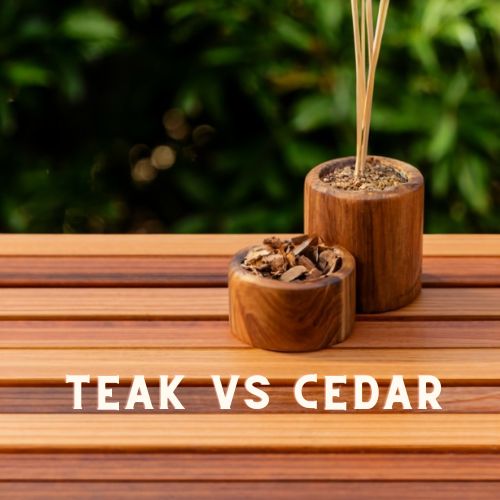Wood is a versatile and timeless material, renowned for its use in furniture, construction, and more. Two woods that frequently take the center stage in this arena are teak and cedar. In this comprehensive guide, we will delve into the world of teak and cedar, comparing their characteristics, uses, benefits, and helping you make informed decisions for your projects.

Table of Contents
- Introduction: The Beauty of Teak and Cedar
- Teak: The King of Hardwoods
- Cedar: The Aromatic Wonder
- Teak vs. Cedar: A Comparative Analysis
- Long-Tail Queries: Exploring Teak and Cedar Use Cases
- FAQs About Teak and Cedar
- Conclusion: The Perfect Wood for Your Needs
1. Introduction: The Beauty of Teak and Cedar
Wood enthusiasts appreciate the rich, timeless beauty of teak and cedar. In this guide, we’ll explore what makes these woods unique and how they can be used to enhance various projects.
2. Teak: The King of Hardwoods
2.1. Characteristics
- Hardness: Teak is a hardwood known for its exceptional hardness and durability.
- Color: It boasts a golden to medium brown color that deepens with age and exposure to light.
2.2. Benefits
- Weather Resistance: Teak is naturally resistant to rot, decay, and pests, making it an ideal choice for outdoor furniture.
- Low Maintenance: Its low maintenance requirements are highly advantageous.
3. Cedar: The Aromatic Wonder
3.1. Characteristics
- Aroma: Cedar is famous for its distinct, pleasant aroma, which serves as a natural repellent for insects.
- Color: Cedar wood varies in color, from pale yellow to reddish-brown.
3.2. Benefits
- Insect-Repellent: The aroma of cedarwood deters insects, making it a preferred choice for closets, drawers, and chests.
- Lightweight: Cedar is lightweight and easy to work with, making it suitable for a range of projects.
4. Teak vs. Cedar: A Comparative Analysis
4.1. Durability
- Teak Durability: Teak’s remarkable hardness and natural oils contribute to its excellent durability.
- Cedar Durability: Cedar is durable, but it is primarily known for its insect-repellent properties.
4.2. Use Cases
- Teak Uses: Teak is often used for outdoor furniture, boat decks, and high-end woodworking projects.
- Cedar Uses: Cedar is popular for closets, chests, saunas, and lightweight construction.
4.3. Maintenance
- Teak Maintenance: Teak requires periodic maintenance to preserve its color, as it naturally weathers to a silver-gray patina.
- Cedar Maintenance: Cedar is low maintenance and retains its appearance for indoor applications.
5. Long-Tail Queries: Exploring Teak and Cedar Use Cases
5.1. Can teak be used for indoor furniture?
Teak is suitable for indoor furniture, but it’s often chosen for its exceptional outdoor performance.
5.2. Are there any alternatives to cedar for natural insect-repellent solutions?
While cedar is well-known for its insect-repellent properties, there are alternative woods and cedar oil solutions available.
5.3. What are the primary differences between teak and cedar decking for boats?
Teak is a preferred choice for boat decks due to its natural oils and resistance to moisture, while cedar is not typically used in this application.
5.4. Is it possible to combine teak and cedar wood in a single project?
Combining teak and cedar can create a unique and aesthetically pleasing contrast in woodworking projects.
5.5. Can cedar be used for outdoor projects with proper finishing and maintenance?
With the right finishing and maintenance, cedar can be used for outdoor projects but is more commonly associated with indoor applications.
6. FAQs About Teak and Cedar
6.1. Is it necessary to apply teak oil to teak furniture?
Applying teak oil is a personal preference, as it can help maintain the wood’s original color, but teak furniture can also age naturally to a silver-gray patina.
6.2. What is the best way to maintain cedarwood’s insect-repellent properties?
To maintain cedarwood’s insect-repellent qualities, lightly sand the surface or reapply cedar oil as needed.
6.3. Can teak and cedar wood be stained or painted for specific projects?
While staining and painting are possible, many prefer to showcase the natural beauty of teak and cedar by leaving them untreated or applying clear finishes.
7. Conclusion: The Perfect Wood for Your Needs
Teak and cedar are exceptional woods, each with its unique characteristics and benefits. The choice between them depends on your specific project and preferences. Whether you’re creating outdoor furniture, elegant closets, or custom woodworks, understanding the distinctions